The small village of Zhostovo, not far from Mytishchi, became known outside the Moscow region (and even Russia) due to its unique, colorful, recognizable among dozens of adjacent painting directions. Zhostovo trays are one of the symbols of Russian folk art. It arose in the 19th century, it could suffer the sad fate of many prematurely disappeared crafts, but Zhostovo painting lives on today.
History of occurrence
In 1825, the village craftsmen Vishnyakov, the serfs of Count Sheremetyev, learned at the manufactory where they worked the technology of varnishing metal products and constructions from papier-mâché. So workshops appeared in the villages of the once Trinity parish, which produced painted products from papier-mâché, varnished. There is another version: the son of the owner of the capital's factory, the miniature painter Vishnyakov gave birth to the eminent craft.
The confusion that arose because of the surnames does not allow us to say exactly who became the ancestor of the famous Zhostovo trays. But in art there is a concept that can be called "the maturation of creativity." So, in that very Trinity volost, in several of its settlements, an atmosphere was created that gave rise to a unique creative direction. And it is not so important who was the first: the Vishnyakov brothers who bought off to the will or a miniaturist with the same surname.


The Zhostovo craft is interesting in that the masters did not have samples, they wrote in their imagination, improvisationally. But behind this improvisation was a clear understanding of the rules and a refined technique. In fairness, it must be said that the motives of painting the trays by the Zhostovo masters were borrowed from Tagil artists. Tagil craft is a century older than Zhostovsky and is characterized by the same finish of metal trays.
In the XX century, Novoseltsevskaya labor artel was formed in Novoseltsevo, one of the villages of Mytishchi district. The company produced lacquered metal trays. Two years later, two more branches were formed in Zhostovo - “Zhostovo Labor” and “Special Workshop”, and after them “Varnisher”, “Own Labor” (only in Troitsk). In 1928, they all merged into a single system.
The geographical location of the village was in the hands of artists: they could, without using the services of intermediaries, sell goods in Moscow. There it was convenient to buy raw materials for work. At the same time, the first Soviet years were not easy for Zhostovo masters: the time came for socialist realism and naturalism in art, and traditional craft became inappropriate. But the artists managed to maintain the direction, interest in which reappeared during the Khrushchev "thaw." Russian creations were presented at international exhibitions, and foreign demand spawned the mass production of inexpensive souvenirs.
Today you can visit the most interesting museum in Zhostovo, the excursions will introduce both small and large visitors not only to the famous trays, but also to other painted dishes, unique technique, plots and features of the old craft.



Description
The key motive of Zhostovo painting was a flower bouquet. In the creative direction, a combination of the realism of the living form of the flower and the decorative community, which is similar to the traditional brush painting, decorating the spinning wheels, chests and tuesochki, is clearly noted. The long-standing development of decorative schemes is laying such a decision for a flower bouquet; they display a set of garden-field flowers - this is an assembled bouquet, a wrap bouquet, a garland and a wreath.
Zhostovo works are characterized by two main features.
- Bright colors. Black background is traditional, but with it blue, green and red options appear. Around the edges of the tray is a light twisted floral ornament.
- Technique, traditional drawing. The artist works with a wide brush - skillfully throws a composition on the tray itself. During work, he makes sure that the floral image is quite expressive, as well as the rhythmic location of colorful spots.
Masters work with squirrel brushes and oil paint. The paint is traditionally diluted with linseed oil, the brushes are washed in a turpentine solution. Each artist has a rich collection of brushes: from thin, with a needle thick, to the largest. And each brush fulfills its own smear.
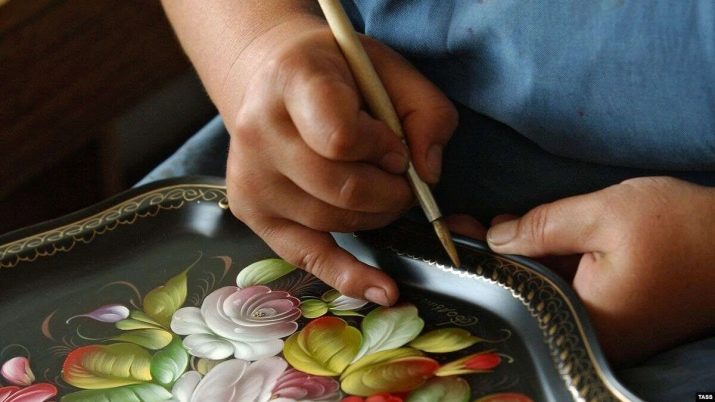
Variety of shapes
Today, factory products are stamped on professional presses that allow you to ask the product any shape. If the workpiece is stamped, then initially the sketch is drawn using a stencil, and then it is already cut down and stretched by electric press.
But there are also exclusive orders, and then the master manually forges the utensils. Koval takes an iron sheet, cuts out the mold with special scissors, then knocks out the mold and draws it out. The edge of the product is rolled up, a wire is glued to it, which gives a relief shape to the product and at the same time strengthens it. Of course, a hand-forged product will be very expensive.
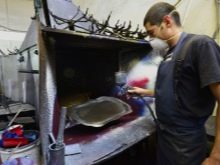
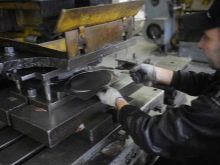

Zhostovo trays can be:
- round;
- oval;
- Guitar
- octagonal;
- rectangular (frequent option);
- winged (with scalloped edges);
- combined.
This is not to say that one form is more popular than another: round and oval trays look more traditional, but guitar ones are in demand, and combined products find their customers (and, by the way, become an interior highlight).



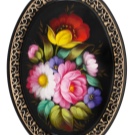

Types of patterns and patterns
In the 21st century, strict canonization, when the background should be clearly black and no more, is no longer respected. Silver, red and malachite background colors are no longer something unexpected with respect to the Zhostovo trays. But the flowers remain the main pattern of fishing. Zhostovites took this subject from the Ural craftsmen, who also artistically comprehended the beauty of wildflowers and garden flowers.
Zhostovo-style painted trays have many recognizable nuances.
- Center plants with large plants, and with such a drawing, as if a flower were growing from the middle of the tray. On the edges - smaller flowers.
- The main print is a flower bouquet or flower wreath, Mandatory and floral ornaments, varying in complexity.
- The choice of colors according to the personal decision of the author. Each artist depicted on a tray those flowers that he liked.
- A modern extension of themes and patterns. Today's masters of Zhostovo painting paint still lifes, birds, animals, landscapes and various thematic images.
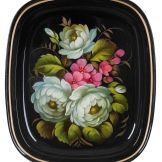
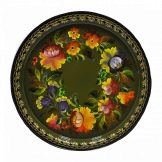

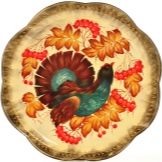
Creativity is a living process. Modern masters who continue and glorify the eminent direction are in search of new ideas (forms, patterns, colors). This does not contradict the canons, but develops Zhostovo painting, partly embeds it in actual creative requests, in no case without impersonating, without depriving individuality.
I must say that this art direction suffers a lot from scammers who produce fakes and pass them off as real Zhostovo trays.

But a fake can be distinguished from the original.
- On this product, there is a stamp-logo of the workshop that produced it.
- Counterfeit trays can have sharp edges, but true masters will never allow such a flaw - the edges will certainly be rolled. Edging is necessary not only from an artistic point of view, but also in order for the tray to gain strength.
- The real tray is quite thick: it should be so in order to keep the samovar and dishes that are served with it. If you put something heavy on the tray, and he caved in, this is not a genuine Zhostovo product.
- This tray has a mirror surface. It is repeatedly primed, each layer is necessarily polished. And the varnish is applied to the surface in at least two layers, each of them is polished. We can say that in the Zhostovo tray everything is reflected as if in a mirror. And if this does not happen, then the lacquering step is skipped, which can only be a fake.
- The perfect technique. Real masters cannot have crooked lines, dull colors, fuzzy drawing. This is unacceptable, everything must comply with the standard, traditions.
For this reason, a too cheap product a priori cannot be a Zhostovo tray. Such a multi-stage painstaking work with clearly verified quality control is not cheap, but it will also serve as a tray for many years.



This is a wonderful gift if you want to give some kind of present from your homeland or just to please your loved ones with a durable, beautiful, classic thing.
Mural stages
The painting of trays from Zhostovo is also distinguished by its layering. The first layer is hiding. The master makes up the whitened paint by spreading color spots, buds and leaves into various compositional schemes. Every spot should find its place and not depart from the author’s intention.
After that, drying begins, and after drying, the master proceeds to the second stage - the shade. The artist paints darker, finer details of the floral elements with transparent paint for glaze.
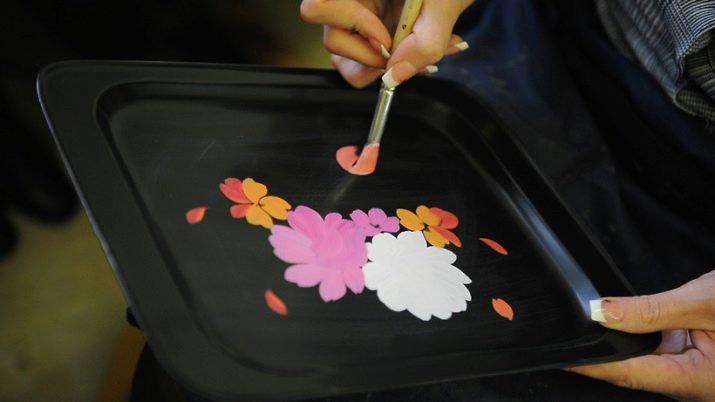
The next step is called a gasket, during which the author writes out light zones with dense and opaque paint. Then comes the glareAnd each master has her own author: who has small, and who has wide. The glare can be compared with the musical rhythm.
The next step is the drawing. The master draws light petal edges, the edges of leaves, flowers, buds. For example, “make a seed” means writing down the smallest details in buds / flowers. Next, the binding begins: the gentle grass filling the empty spaces between the elements makes the composition a single, harmonious one.
One master pays great attention to binding, painstakingly prescribes the smallest details, the other works according to minimalistic principles. For one author, the binding will be bright; for another, it will fit dynamically into the background of the tray.


At this stage, the painting of the tray actually ends: the tray is dried and transferred to the ornamentalist.
If you schematically depict the process of working on a tray, it will include a series of steps.
- Faint shade of the main color the master draws sketches of flowers and other components of the composition.
- Further, the artist works on translucent shadows. At this stage, inflorescences and leaves are drawn.
- Colors are shaped using the finish shade.
- After drying, the author puts glare on the picture, which will give it volume.
- Thin brush the author draws the smallest details of the work that complete it.
- Work is underway on the background of the picture.
- An ornament is applied to the edges of the tray - usually these are flowers or a geometric figure. This procedure is considered to be finishing, but it is impossible to imagine a Zhostovo tray without it.
Today it is not necessary to remotely comprehend the secrets of the excellence of the Zhostovo craft. The only Zhostovo studio was opened in Moscow, where the best masters teach everyone.
In special courses, you can take more advanced training.
You can take a closer look at the tray production process.









